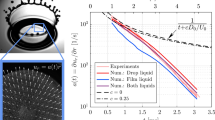Summary
Studies have been made of the charge transfer resulting from the collision and separation of water drops falling in an electric field. The charge transferq was measured for values of field strengthE, impact velocityV, drop radiiR, r, radius ratioR/r, and angle Θ ranging from 0.5 to 80 kV/m, 0.5 to 3 m·sec−1, 200 to 600 μ, 1.0 to 3.0 and 0 to 90 degrees respectively, where Θ is the angle between the field and the line of centres of the drops at the moment of separation.
Two uniformly sized drop-streams were ejected from hypodermic needles by modulating the flow of water through them and then collided between a pair of electrodes across which a potential difference existed. The drops coalesced temporarily, swung around each other and separated, each resulting stream being collected in a vessel connected to an electrometer in order to measure the charge. The measured values ofq were generally in good agreement with theoretical values derived from the equationq = 1.1 · 10-10 γ1 E r 2 Cos Θ, where γ1 is a function ofR/r.
Calculations based on this equation, the Marshall-Palmer drop-size distribution and established values of separation probabilities of colliding drops showed that collisions between raindrops within electrified clouds will act powerfully to dissipate the existing fields.
Zusammenfassung
Die Ladungsübertragung infolge von Zusammenstoß und nachfolgender Trennung von Wassertropfen, die in einem elektrischen Felde fallen, ist untersucht worden. Die übertragene Ladungq wurde, gemessen bei Werten der FeldstärkeE, des Tropfenradiusr, des RadienverhältnissesR/r, der Zusammenstoß-GeschwindigkeitV und dem Winkel Θ in den Bereichen von 0,5 bis 80 kV/m fürE, 200 bis 600 μm fürr, 1,0 bis 3,0 fürR/r, 0,5 bis 3 m/sec fürV und 0 bis 90° für Θ. Θ bedeutet den Winkel zwischen der Feldrichtung und der Verbindungslinie der Tropfenmittelpunkte im Augenblick der Trennung.
Zwei gleich große Ströme von Tropfen wurden aus hypodermischen Kanülen ausgestoßen (durch Beeinflussung des Wasserstromes durch diese). Diese Ströme wurden dann zum Zusammenstoßen gebracht in einem Raum, in der durch zwei Elektroden ein elektriches Feld aufrechterhalten wurde. Die einzelnen Tropfen stießen vorübergehend zusammen, bewegten sich dann umeinander und trennten sich wieder, wonach jeder der beiden Ströme in einem isolierten Gefäß aufgefangen wurde, welches zur Ladungsmessung mit einem Elektrometer verbunden war. Die gemessenen Ladungen waren im allgemeinen in guter Übereinstimmung mit den aus der Gleichungq = 1,1 · 10-10 γ1 E r 2 Cos Θ berechneten, worin γ1 eine Funktion vonR/r darstellt.
Aufgrund dieser Gleichung, der Marshall-Palmerschen Tropfengrößen-Verteilungsfunktion und annehmbarer Werte für die Trennungswahrscheinlichkeit zusammenstoßender Tropfen durchgeführte Berechnungen zeigten, daß Zusammenstöße zwischen Regentropfen in elektrifizierten Wolken zu einer Zerstörung des bestehenden Feldes kräftig beitragen.
Similar content being viewed by others
References
Atkinson, W. R., and A. H. Miller: Versatile Technique for the Production of Uniform Drops at a Constant Rate and Ejection Velocity. Rev. Sci. Instr.36, 846–847 (1965).
Brazier-Smith, P. R., S. G. Jennings, and J. Latham: The Interaction of Falling Water Drops; Coalescence. Proc. Roy. Soc. London, A,326, 393–408 (1971).
Davis, M. H.: Electrostatic Field and Force on a Dielectric Sphere Near a Conducting Plane. — A Note on the Application of Electrostatic Theory on Water Drops. Amer. J. Phys.37, 26–29 (1969).
Latham, J., and B. J. Mason: Electric Charging of Hail Pellets in a Polarizing Electric Field. Proc. Roy. Soc. London, A,266, 387–401 (1962).
Marshall, J. S., and W. M. Palmer: The Distribution of Raindrops with Size. J. Meteor5, 165–166 (1948).
Mason, B. J.: A Critical Examination of Theories of Charge Generation in Thunderstorms. Tellus5, 446–460 (1953).
Sartor, J. D.: The Role of Particle Interactions in the Distribution of Electricity in Thunderstorms. J. Atm. Sci.24, 601–615 (1967).
Author information
Authors and Affiliations
Additional information
Dedicated to the memory of Prof. Hans Israël.
With 5 Figures
Rights and permissions
About this article
Cite this article
Jennings, S.G., Latham, J. The charging of water drops falling and colliding in an electric field. Arch. Met. Geoph. Biokl. A. 21, 299–306 (1972). https://doi.org/10.1007/BF02247978
Received:
Issue Date:
DOI: https://doi.org/10.1007/BF02247978




